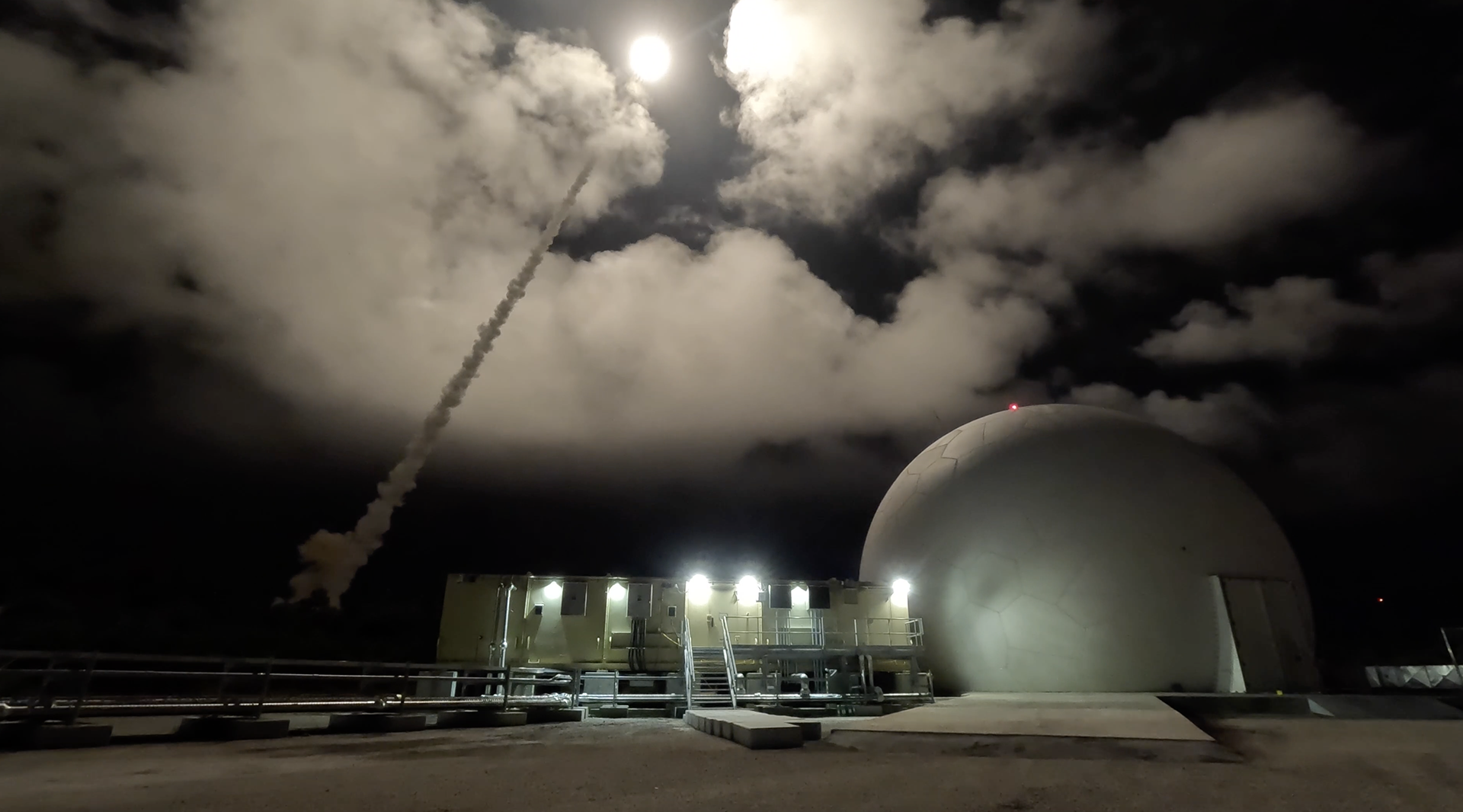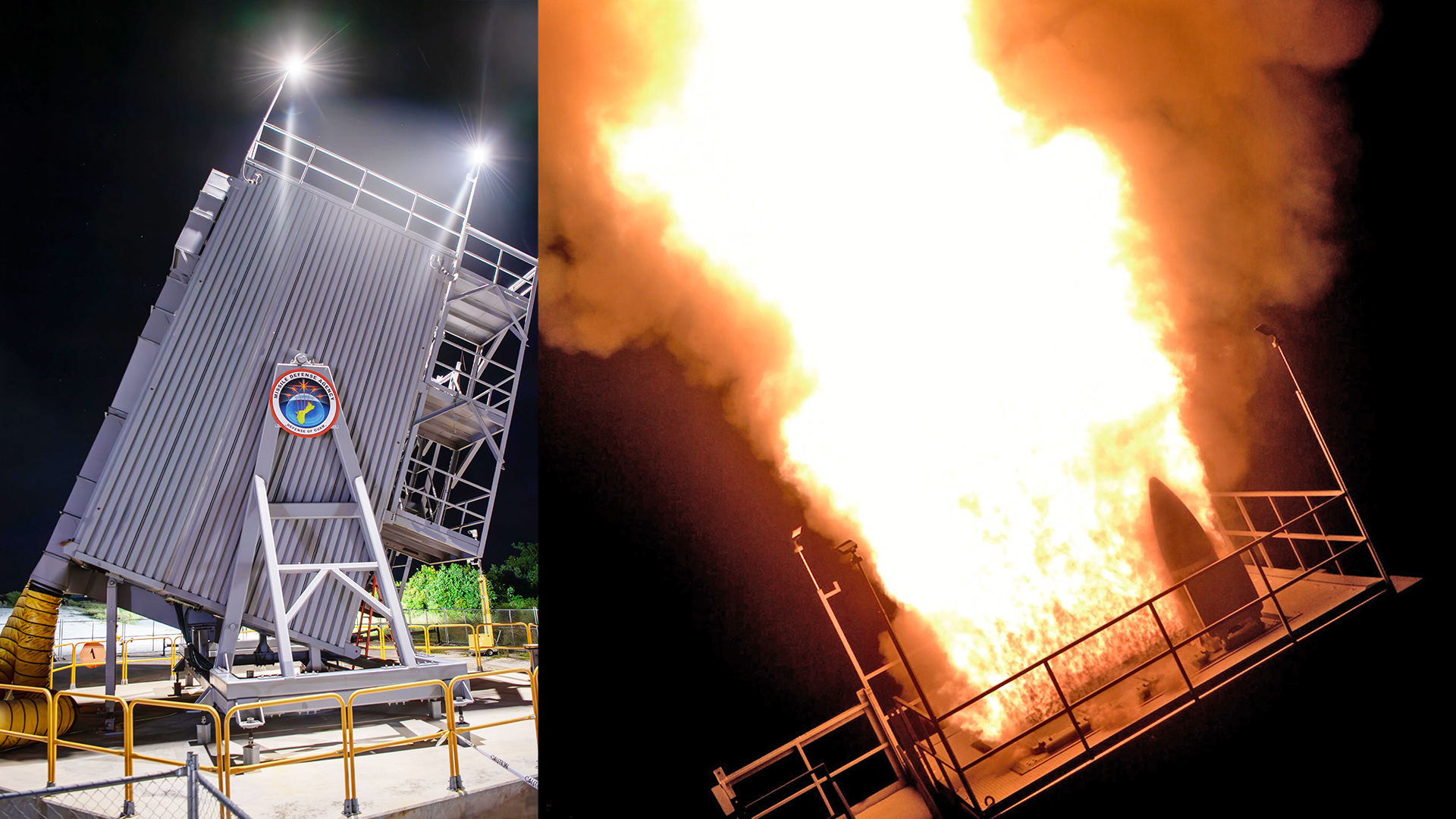The U.S. Missile Defense Agency (MDA) conducted its first live intercept of a ballistic missile from the West Pacific island of Guam on Tuesday. The successful test also highlighted new details about the launchers used with the new Aegis Guam System, initial information about which The War Zone was first to report on.
The test launch, dubbed Flight Experiment Mission-02 (FEM-02), is considered a key step toward providing 360-degree protection for the strategic outpost, which is on its way to becoming the most densely protected piece of land on the planet. It saw the Aegis Guam System fire a Standard Missile-3 Block IIA (SM-3 Block IIA) to intercept a mock air-launched medium-range ballistic missile (MRBM). The target MRBM was successfully hit more than 200 nautical miles to the northeast of the island, according to the MDA and the U.S. military’s Joint Task Force-Micronesia.

The Aegis Guam System fired the SM-3 Block IIA from a launcher based on the Mk 41 Vertical Launch System (VLS). A picture released by the agency and Lockheed Martin, seen below, reveals that the launcher can actually tilt at least in one direction and can sit vertical for loading weapons and servicing. This is unlike the fixed launcher towers used in existing Aegis Ashore systems. We have reached out to Lockheed Martin, the defense contractor behind the launcher, for more information about this launch system and what benefits it offers. Tilting the launchers to the west, where threats would primarily emanate from, could potentially add a bit more range to some weapons. And every mile would count when it comes to defending the island from a multi-layered missile attack.


The test also marked the first end-to-end engagement utilizing the AN/TPY-6 radar during a live ballistic missile defense test, according to the agency, and is the first demonstration we’ve seen of the growing, layered and integrated air and missile defense web that will blanket the island.
AN/TPY-6 is based on the same technology as the AN/TPY-7 Long Range Discrimination Radar (LRDR), according to manufacturer Lockheed Martin. The LRDR is currently used in Alaska, and was also planned for Hawaii, but funding has since dried up for the Hawaii effort, Inside Defense reported in 2023.
Guam, about three times the size of Washington, D.C., hosts U.S. Navy combat vessels and rotational deployments of combat aircraft, along with many other capabilities, including military communications and surveillance systems. It is a central cog in the Pentagon’s strategic deterrence efforts in the Indo-Pacific region. During a crisis, the island’s port and airfields would be flooded with U.S. and allied troops and platforms. Few American missions in the region are arguably more critical than protecting Guam.
As such, Beijing would place Guam and its U.S. Navy, Air Force and Marine Corps forces in the crosshairs should a full-scale conflict erupt. China’s growing arsenal of ballistic missiles pose the greatest threat to the strategic island outpost.

“The future is focused on defending Guam and protecting forces from any potential regional missile threats,” the MDA said in a statement.
Tuesday’s test was part of an ongoing buildup of the so-called Guam Defense System (GDS), which is also referred to in online military records as the Enhanced Integrated Air and Missile Defense (EIAMD) system. It will lean on as many as 20 new air defense sites bristling with surface-to-air interceptors, radars and other assets to counter an attack if war with China breaks out.
The MDA test also showcased the joint, interlocking nature of Guam’s defense, and how that task would likely involve not only the U.S. military services but regional allies as well.
While the surrogate threat missile was tracked from Aegis Ashore, the Navy destroyer USS Milius (DDG-69) also detected, tracked and simulated engaging the ballistic missile, providing another layer of sea-based missile defense, according to Joint Task Force-Micronesia. Meanwhile, a U.S. Army Terminal High Altitude Area Defense (THAAD) unit based on Guam also tracked the missile, while the Japanese destroyer JS Haguro (DDG-180) “exercised its air defense support” as well.

TWZ first reported on the plans for drastically beefing up Guam’s defense in August 2023, as military authorities worked to inform local residents of the effort and how it would impact their lives. The Aegis Ashore system that was used in Tuesday’s test is at the core of the Guam defense plan, but it looks very different from other U.S. Aegis Ashore sites in Romania and Poland, the latter of which was declared mission-ready in July 2024. Romania’s system has been in operation since 2016.
While the final configuration of Aegis Ashore on Guam remains to be seen, the MDA has noted that it will be distributed to a far greater extent than its predecessors, and could involve certain components being placed in hardened underground facilities or road-mobile ground platforms, TWZ reported.
Guam’s Aegis system differs in other ways as well, according to an October 2024 TWZ report that highlighted initial glimpses of the Mk 41 VLS there:
“Aegis Ashore is primarily designed to engage ballistic threats during the midcourse portion of their flight outside the Earth’s atmosphere using SM-3 interceptors. However, the Mk 41 is a modular launcher, meaning that additional anti-missile interceptors, such as the terminal-stage intercept and anti-air SM-6 and the forthcoming Glide Phase Interceptor (GPI), which could also be added. With its ability to take down certain incoming hypersonic threats, as well as other weapons, the GPI could be especially relevant for the defense of Guam. With additional launchers, even dispersed around the island, shorter-ranged missiles, such as the Evolved Sea Sparrow Missile (ESSM) Block II and even the latest SM-2s, could feasibly provide protection against air breathing threats, such as cruise missiles and drones. Patriot interceptors are now also now a possibility.”
A map published by the MDA in October 2024 reveals 16 proposed sites across the island for air defense system assets, including Ritidian Point at Guam’s northern end, Naval Base Guam’s (NBG) Barrigada site in the middle of the island and a location within the Naval Munitions Site (NMS) to the south.

Another map shows nine radar arcs, including a comparatively larger arc projecting from Ritidian Point, which is now under the jurisdiction of the Marine Corps’ new Camp Blaz.

Other air systems that could engage various types of ballistic and cruise missiles, as well as fixed-wing aircraft and drones, during an attack include Patriot surface-to-air missiles and lower-tier anti-air missile systems to include medium-range and short range (SHORAD) systems, as well as possibly directed energy weapons in the future. Go here to read more about the lower-tier capabilities that will protect Guam.
Precisely when all the planned GDS pieces will be installed and ready to operate remains unclear, but officials have said they want at least some of the components operational by 2026.
While much remains to be seen, Tuesday’s takedown of a ballistic missile threat underscored one way that the Pentagon plans to lock down Guam’s airspace in the event of crisis, and how it will need a panoply of systems to accomplish this vital task.
Contact the author: geoff@twz.com
Contact the author: joe@twz.com
